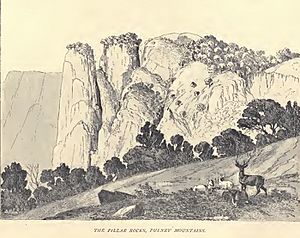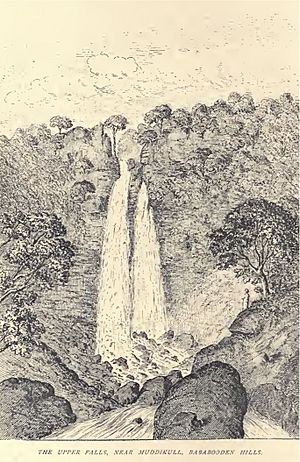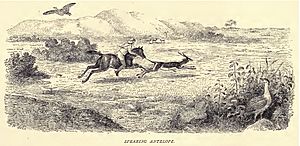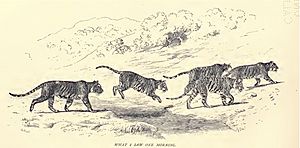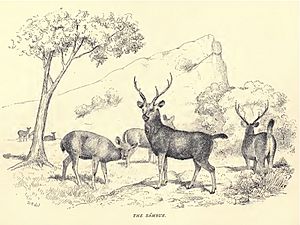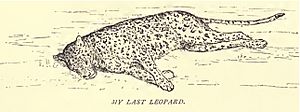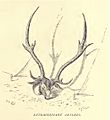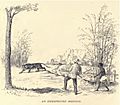Douglas Hamilton facts for kids
General Douglas Hamilton (born April 8, 1818 – died January 20, 1892) was a British officer in the Indian Army. He served with the 21st Regiment of the Madras Native Infantry from 1837 to 1871. Hamilton was well-known for surveying early British hill stations in South India. He was also a famous sportsman, big-game hunter, and collector of trophies. He was a keen observer of nature and a true gentleman. He is known to have shot more game in the Nilgiri Hills than any other sportsman.
Contents
Early Life and Family
Douglas Hamilton was born on April 8, 1818. He attended Harrow School in England. He was the youngest of eight sons of Charles Hamilton. His father worked at the War Office.
Douglas's brother, Edward, helped publish his autobiography in 1892. It was called "Records of sport in southern India..." The book talked about a time when muzzle loader guns were commonly used for hunting. Another brother, Richard, was also a well-known sportsman. He wrote a book called Game under the name "Hawkeye."
Military Service and Conservation Work
In 1834, Douglas Hamilton joined the East India Company's military school, Addiscombe Military Seminary. He became an officer in the East India Company's Army in 1837. He was assigned to the 21st Regiment of the Madras Native Infantry. He traveled to India, arriving in Madras in December 1837.
His regiment was sent to Kulladghee in the Bombay Presidency. Later, in 1846, he went with his regiment to Singapore. He even took leave to visit Java for hunting in 1848. He returned to England for a break in 1849 and came back to India in 1852.
Douglas was very interested in forest conservation in South India. He often visited his friend General James Michael, who was setting up a forest conservation project in the Annaimalai Hills. Douglas was asked to manage the project temporarily in 1854 when Michael was ill. He was very good at these new forestry duties.
In 1857, Douglas took over the Annaimalai forests permanently. For three years, he managed the forests, providing teak wood for shipbuilding at the Bombay Dockyard. He also worked as an Assistant Conservator of Forests under Hugh Francis Cleghorn. Cleghorn helped create the Madras Forest Department, which led to the Forest Department of India.
In 1860, Hamilton's regiment went to Hong Kong. He returned to Madras in February 1861.
Surveying Southern India's Hills
In 1862, Douglas Hamilton was given a special job by Sir Charles Trevelyan. Trevelyan was the Finance Minister of India. Hamilton's task was to survey and draw all the hill plateaus in Southern India. These areas were being considered as healthy places for European soldiers to live.
Hamilton made many detailed drawings by Douglas Hamilton of the Annaimalai Hills, Palani Hills, and Shevaroy Hills. While doing this work, he also had many chances to hunt and observe different animals. His drawings showed how carefully he observed nature. Each set of drawings came with a Survey article describing the area.
For example, in 1864, Hamilton described the Berijam Swamp area. He thought it was the best place in the Palani Hills for a military camp or health resort. He imagined a lake being rebuilt there to attract people. A military outpost, Fort Hamilton, was later named after him in that area.
In March 1866, he went to the Budan Hills to make drawings and a report. In August 1870, he took three months' leave due to poor health and visited Australia. He returned to Madras in November, feeling much better.
Douglas Hamilton had a long military career with many promotions:
- Ensign: 1834
- Lieutenant: 1837
- Captain: 1838
- Major: 1858
- Lieut.-Col.: 1862
- Brevet colonel: 1867
- Substantive Colonel: 1874
- Major-Gen.: 1877
- Lieut.-Gen.: 1882
- General: 1888
Adventures in Big-Game Hunting
Douglas Hamilton's first experience with big game hunting was in Kulladghee in 1839. At that time, Blackbuck antelopes were very common.
In 1854, Hamilton bought a hut at Pykara. For many years, he hosted friends there for hunting trips. Among his guests were Prince Frederick of Schleswig Holstein and General James Michael. He still owned the hut when he passed away 38 years later.
During his career, he observed over 50 wild tigers. In 1854, he hunted his first tiger in the Nilgiri Hills. One tiger he hunted in 1857 was about 249 cm long and 97 cm tall at the shoulder. A friend of Hamilton's, Colonel Nightingale, once hunted eight tigers in six days. This included a tiger known for attacking people. That tiger was 127 cm tall and 309 cm long.
In 1855, in the Annaimalai Hills, he hunted his first elephant. It was a large male elephant, about 279 cm tall at the shoulder. Its tusks were about 14 cm wide and 164 cm and 145 cm long.
In 1863, at Hassanoor, Hamilton and Sir Victor Brooke hunted the largest elephant ever recorded in Southern India. This elephant was about 3.35 meters tall at the shoulder. It had one perfect tusk that was 244 cm long.
Between 1855 and 1869, Hamilton hunted 295 sambar deer. The largest sambar ever hunted in the Nilgiri Hills was by Hamilton. It stood about 142 cm high at the shoulder. Its antlers were about 105 cm and 98 cm long.
In 1856, a large injured bison bull attacked and ran over him in the Annaimalai Hills. Luckily, he only had minor injuries. The bison's larger horn was about 89 cm long. He hunted his last bison in 1866.
He did not hunt many leopards. However, he did hunt a beautiful black leopard near his hut in 1857. He hunted his last leopard in 1870. It was an old male, about 188 cm long, with a lovely skin.
In 1861, Hamilton recorded 114 different kinds of birds near Kodaikanal.
Return to England and Later Years
On June 20, 1871, Douglas Hamilton finally left India after serving for 35 years. He arrived in England on July 19.
The "Oriental Sporting Magazine" wrote about his departure. They said he was a true friend, a kind gentleman, and a keen observer of nature. They noted that he had legitimately hunted more game in the hills than any other sportsman. They also mentioned that seeing his trophies and hearing his hunting stories was a great experience.
From 1872 to 1887, he rented a moor and deer forest in Scotland each year. He loved to go deer stalking there. Many large stags were hunted by him. The fresh air of the Highlands helped him regain his health and strength.
He seemed to handle hard work and tiredness well until the autumn of 1887. After being exposed to bad weather, he caught a severe chill. From that point on, even though he seemed to get better at times, his health never fully recovered. After a sudden illness, he passed away on the night of January 20, 1892.
Images for kids


